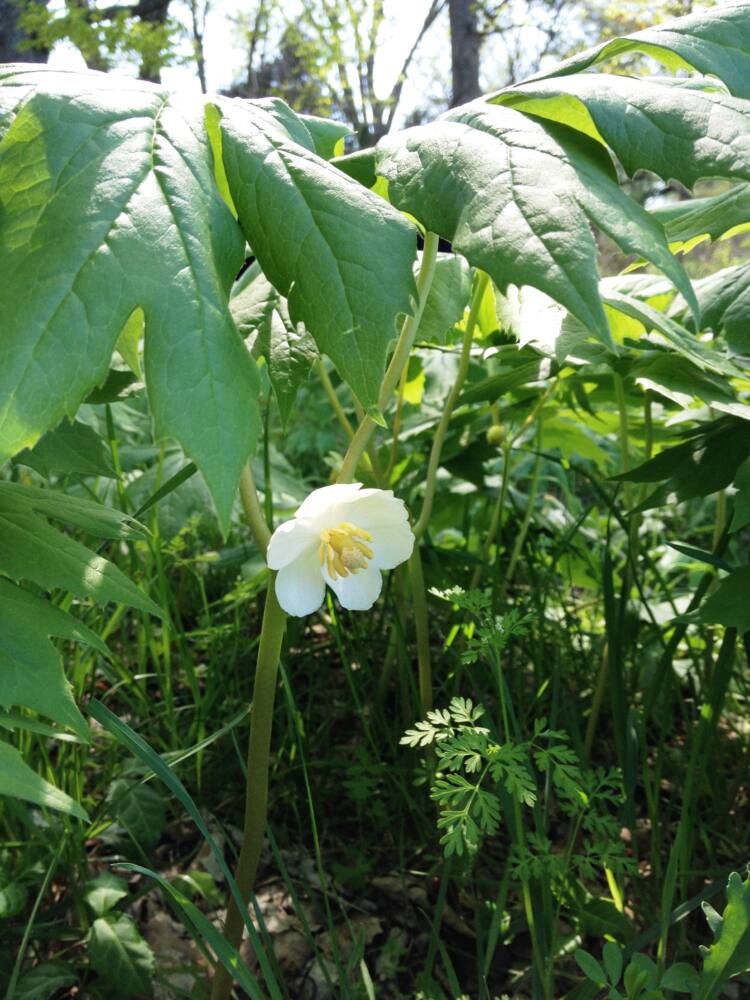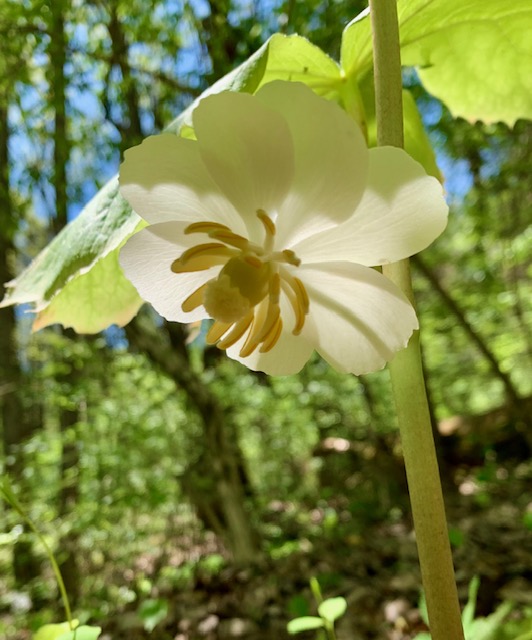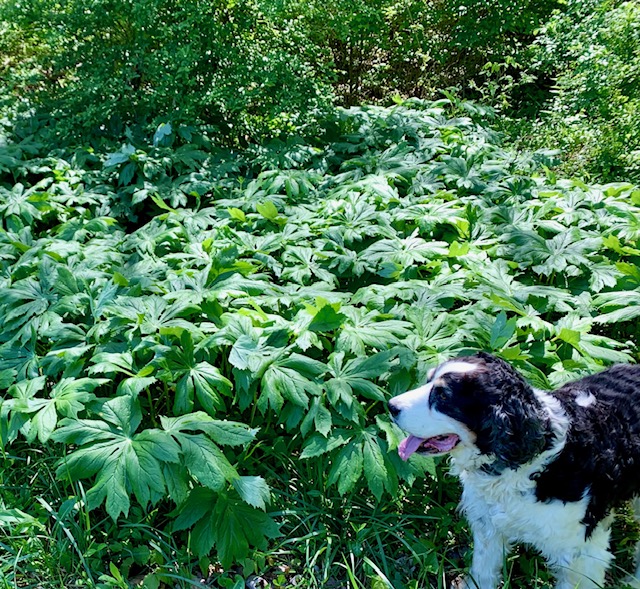Have you ever been walking through a wooded area or near one and come across a large patch of unbrella shaped leaves? Then you may have found a patch of Mayapple flowers. They grow prolifically in several places out here on the farm. One spot is at the edge of a hayfield. Every year they get cut down. Every spring they bravely come back. Since early spring had some summer type warm days, I think the Mayapples are ahead of schedule. That means those in the hayfield have plenty of time to bloom and start making that round fruit under the canopy of two leaves.
I’ve always thought they were called Mayapples because of that fruit that could look like an apple, I found out that wasn’t true when I went searching for Mayapple information today. One place said that although the name suggests the apple-like fruit that begins forming in May after the flower blooms, the name actually makes reference to the fact that the flower which blooms in May looks similar to an apple flower! Hmm, I’m not so sure about that. I can go along with the bloom looking like an apple bloom but it could be the fact that a green round fruit forms from that flower might also have something to do with the name.
But I’m not an expert. That’s why I went out online to check out experts’ facts about the flower. I did know this first one that the Mayapple is a shade-loving plant. I hadn’t thought about how it spread, but if I had, I might have realized that they slowly spread through rhizomes, something like iris plants. Because of this, when you find that patch of Mayapples, they will be a colony of genetically identical plants.
Even though its blooms (one per plant) hide under those canopies of leaves, they have a pleasant fragrance that attracts bee, flies, and beetles. I don’t think I’ve ever sniffed one of the flowers. So that’s on my ‘to do” list this spring. Once the fruit matures, wildlife, box turtles, raccoons and more, eat it and spread the seed that can also make new plants. I saw a plant in the middle of the hayfield today that was away from any shade. Must have been a seed carried there by one of those box turtles.
The dense canopy formed by large leaves of the Mayapple offers shelter for small animals, such as salamanders and insects, during rainstorms. Loved finding this fact since I could imagine field mice, dragon flies, and various other little creatures crouched under those leaves to stay dry.
The Mayapple is a hardy plant that ranges across at least 34 US states and three Canadian provinces. Now here’s one I didn’t know but maybe should have. Mayapples produce a toxin called podophyllotoxin, which is highly poisonous if ingested in a significant quantity. That helps to explain why mayapple leaves nearly always appear perfectly intact. Animals know what not to eat. All parts of the plant are poisonous except the fruit.
Native Americans knew the plant had medicinal properties. They and early settlers used the roots of the mayapple as a purgative, emetic, “liver cleanser”, worm expellent, and to get rid of warts. Roots were also used for jaundice, constipation, hepatitis, fevers and syphilis. Modern science has capitalized on the toxin’s unique organic structure to derive hundreds of chemical substances that are either current or potential medicines. Some have been used or are being developed to treat some cancers. The use for podophyllotoxin in cancer treatment appears to be to disrupt cell division which impedes tumor formation.
The only part of the Mayapple plant that can be eaten is the fruit, that Mayapple apple. It is edible when fully ripe, but unripe fruit and other parts of the plant are toxic. The fruit is said to have a wonderful exotic flavour. One source said the mayapple flavor is unique, sweet and tart with a grape-pear flavour that has hints of citrus. Not a flavor of a fruit typically found more in the northern parts of the country and Canada. The fruit is not ripe until it becomes soft and yellow. I don’t think I’ve ever seen a ripe one, but then I haven’t looked for it. Maybe something else I should add to my “to do” list since some of the sites claim it is a midsummer treat worth finding. The problem is that the fruit has a pungent odor that attracts lots of critters. So those who do seek the fruit consider it a victory if they get to it before the raccoons or box turtles do.
So, now you may know more about a Mayapple flower and fruit than you ever wanted to know, but I had fun finding out about this plant that is so easy to find here on the farm.
Have you ever seen a Mayapple plant? A Mayapple apple? Tasted one?
Keep in mind that it is toxic, and although the fruit is supposed to be safe to eat when it is ripe, most of the sites suggested not eating much. That if you did, you might find it really does have some of those less wanted effects that the Native Americans used it for. I wonder how it was supposed to get rid of warts. Rubbing it on the wart?

In some Native American folklore, Mayapple was associated with fertility and was believed to bring good luck when found in the forest.



Comments 23
Ann, thank you for the fun and interesting article on Mayapple plant, flower, and fruit. I went for a walk in a nature preserve yesterday and these plants covered the ground. And, I wanted to know more about them.
Author
Glad my post was timely for you, Dipika. I enjoyed learning more about them online too. I’ve been seeing them for years in my fields but had never tried to learn more about them until now.
Thank you for the lesson on mayapples! We have them in our woods and we were discussing them just the other day. Oddly enough, we saw several box turtles in the woods that day also. We have never noticed so many before. Perhaps the mayapples draw them in.
Author
Maybe those box turtles were checking out how the Mayapples were cming along and marking their location for later when they could come back and get a tasty apple meal. Glad I was timely for you in this post, Amy.
Such an interesting article, Ann! Thank you so much for sharing your photos, as well as the information about the mayapple.
Author
Glad you enjoyed reading about the Mayapples, Roberta. I hadn’t planned to delve so much into Mayapple info, but when I went online, I found so much that was interesting to me that I thought some of you would like finding out more about the plant too. The fact that it was poisonous was something I learned. No wonder the leaves are never nibbled on.
I don’t remember seeing any Mayapples, but maybe I just didn’t know what I was looking at. I enjoyed learning all the information about them though. Thanks for passing it on to us.
Author
They may not grow in your area, Connie. You might be too far south if I’m remembering correctly where you live. Plus they do love wooded areas. Glad you enjoyed reading about them.
No I have not seen one, had actually not heard of one until today. Thanks for sharing. There is alway so much to learn. Thanks Ann
Author
I think there are probably Mayapplesl down around whre you are. Maybe. You’ll have to watch for one, Pamela.
Thank you for a fascinating read about the Mayapple. I remember coming across them as a young girl when walking in the woods behind our home in Virginia. I did not know what they were then, I just thought that the blooms were lovely. I always enjoy learning new things and I now have a new wrinkle in my brain for today.
Author
A new wrinkle in your brain, Becky. What a fun way to think about learning something new. Sometimes I’m not sure my wrinkles are not getting smoothed out before I want them too. 🙂 I’m glad you enjoyed reading about the Mayapple.
I have never seen a Mayapple plant. The bloom is lovely, although not as much like an apple tree blossom as I thought it would be. I would love to eat the fruit. Thank you so much for the information! I love plants and reading about them. I use a plant app on my phone when walking. One of my favorite is Maryland Meadow Beauty.
Author
I’ll have to look uo the flower you mention, Karen. It sounds vry pretty. Not sure if I’ve ever seen one or not. I have a plant app on my phone that I use some of the time. Sometimes you have to decide which flower looks most like the one I’m seeing.
May apples are abundant here. I commented to my husband on the way to church yesterday that the May apples were up everywhere. I have never eaten one but read an article on them last week. Have a blessed day.
Author
Seems like I was right on time with the info on the Mayapple since you just saw one and read about them, Lucy. They are an easy wildflower to spot in the spring. I always have to peek under the leaves for the bloom. One fact I didn’t put in the post was that it takes several years growth before they can bloom. I did know they have to have two leaves before they have a bloom.
Thank you for all that info about Mayapples. It’s one of the first plants I’ve always looked for in Spring. I just saw a large colony of them yesterday at the edge of the woods nearby. I’ve always heard the Mayapple is poisonous but assumed it was the fruit. Funny that it turns out that’s the only non-toxic part. I don’t intend to try tasting it, though.
Author
Colony is a good name for the patches of Mayapples, Lee. I had never known they were poisonous but always wondered if the fruit was edible. Guess it is by many animals.
Thanks for all the information.
I have seen the plants, but didn’t know they were poison.
Author
I didn’t either, Marlene, until I went hunting for info out on the net.
I never heard of Mayapple Flowers or Fruit. Your article is very interesting and I am glad I read it. I think that if I were where they grow I would not be “brave” enough to try eating any of the fruit, though. Thank you for the information. I always enjoy reading your posts.
Author
Since i’ve never seen a “ripe” mayapple, Ann, I doubt that I will ever try one either. If I did, it would probably be a very small nibble, because the same as you, I wouldn’t be brave enough to try a big nibble. Glad you enjoyed the post.
I always have seen mayapple plants, but I’ve never thought about the fruit from it. Thank you for an interesting blog.Now I’ll look at them more closely,next time I see some.